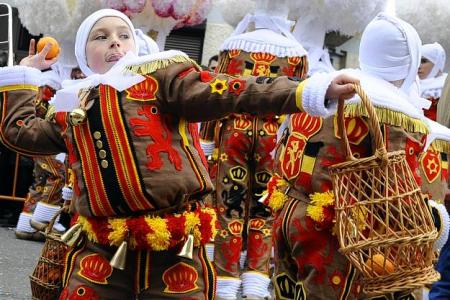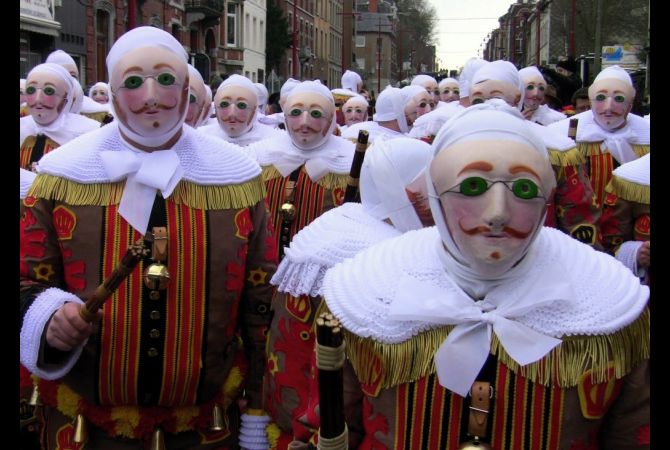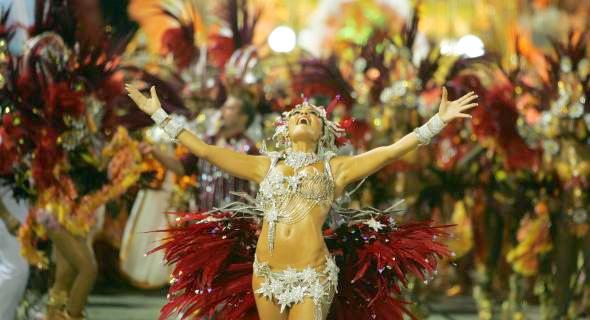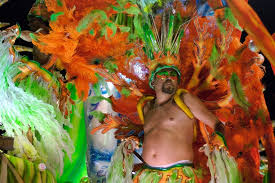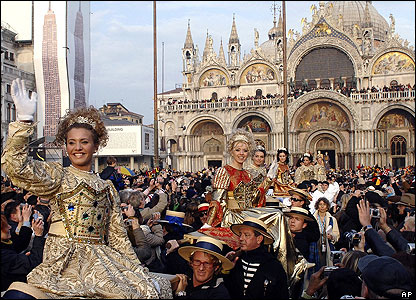Carnival
Brazilian Drought Threatens Carnival Celebrations!
0Brazil is suffering from the worst drought in over 80 years. Crops are dying from lack of water, millions of Brazilians are short of drinking water, and electrical blackouts are common. The drought has been worsening for over a year and has decimated southeastern Brazil, the nation’s richest and most densely populated region. As the Southern Hemisphere enters into the zenith of its summer season, the drought continues to worsen.
Over a dozen cities and towns in the southeastern state of Minas Gerais have called off or scaled back their Carnival celebrations. Ouro Preto is a city in the state of Minas Gerais, Brazil, a former colonial mining town located in the Serra do Espinhaço mountains and designated a World Heritage Site by UNESCO because of its outstanding Baroque architecture, has been forced to rotate outages to ensure ample water for the 70,000 tourists who descend on Ouro Preto for Carnival.
In Brazil’s largest city, San Paulo, where water levels are alarmingly low, city council member Gilberto Natalini has called on the mayor and state governor to cancel Carnival and other humongous water intensive public events for the foreseeable future. It would be like dancing samba on a funeral, Mr. Natalini said.
Oliveira, with a population of 42,000, has canceled all 2015 festivities due to very low water supplies. They usually receive 20,000 Carnival visitors for its one week long Carnival celebration. The president of Oliveira’s Carnival Commission, Antonio Penido, said, Never in the history of our city has something like this happened. With broken hearts, we made the decision.
When the world thinks of Brazilian Carnival, it is Rio de Janeiro that comes to mind. The most out of this world and over the top version of Carnival will go on as scheduled with some concessions to current events. At least two of the large professional samba schools that create the event are scaling back water elements on their over-sized parade floats.
Light and mirror effects will be utilized instead of water to depict a rushing 20-foot fountain of youth for the Uniao da Ilha do Governador samba school in Rio. Tourism officials in Rio are expecting almost a million Carnival tourists, who are expected to spend three quarters of a billion dollars on all the myriad of tourist restaurants, lodging, souvenirs, transportation and deluxe parade seating and event packages.
Police Shortage is Mardi Gras Security Risk!!
0This is only the second or third story that will go on both of my blogs. Crime and Mardi Gras do occasionally mix.
There are signs all over the French Quarter which state Caution: Walk in Large Groups. We (heart) N.O.P.D. We Just Need More. This isn’t a good sign for a city about to enter one of the biggest holidays of the year, Mardi Gras. Approximately 1 million visitors descend on New Orleans each Carnival season and most will hit the Quarter soon after arriving. They will be greeted by a French Quarter bathed in unsettling signs.
Security is a growing concern to many New Orleanians and Americans. When New Orleans is perceived as a dangerous place, less people make plans to visit. The streets of New Orleans during Carnival are full of state troopers, federal agents, virtually half the police force at one time, plus scads of private security personnel. Downtown there are a lot of weirdos that make it down to Mardi Gras also.
In the last 11 years, at least 27 people were injured and one killed on parade routes and Bourbon Street. That is one horrific statistic. Carnival has historically had a violent side. I personally have been very close on St Charles Avenue to a major shooting incident a decade ago. I’ve had very large groups with me at times and much smaller at other, but no one in my group has ever been accosted on the parade route or downtown or in Metairie or other parades around the metro area.
Another growing trend, private security cameras, have caught many of these assaults and shown the brazenness of the perpetrators. The variety of weapons employed is staggering. This footage shows up on YouTube and adds to our collective anxiety.
Since Katrina, the New Orleans Police Department (NOPD) has lost about 500 officers, and I’ve written about this problem recently on my other blog about jail and justice in New Orleans here. Michael Glasser, president of the Police Association of New Orleans, a police union, says I have been to some roll calls where there is one cop, two cops. Mayor Mitch Landrieu would like around 1,600 officers. I’ve authorized as much overtime as is necessary, says our Mayor.
The Mayor has personally felt the sting of crime very recently. One of his personal vehicles was stolen in front of his home over the weekend. The 2006 Jeep was recovered within blocks of his house by an off duty Jefferson Parish Sheriff’s deputy. The Jeep was equipped with LoJack technology. The deputy was heading home across the Mississippi River bridge after finishing a 12 hour shift. His LoJack receiver in his patrol car picked up the signal. He called in the information and found out the car belonged to the mayor of New Orleans. He followed the signal and found himself near the 2nd District Police station. He stopped and checked in, then began pursuing the stolen vehicle again. He ran into the Jeep at General Taylor and Constance streets.
Turns out the New Orleans police never received the LoJack signal as Jefferson Parish did. Hmmm.
According Glasser, This shows crime is not limited to a handful of people in the traditionally ‘bad areas.’ Anybody can be a victim, and ironically, the victim in this case is the person screaming the loudest that crime is down. And while he admits there’s a staffing shortage, I think he underrates the importance of that.
Mardi Gras Around the World Series- Carnival of Binche, Belgium!!
0This is a smaller Mardi Gras than most, though it is beginning to get on the map due to their heavy duty, one of a kind Mardi Gras tradition. Binche is a Belgian town of 32,000 near the French border. They have a Mardi Gras folk tradition dating back to the 14th century, that UNESCO has designated a cultural treasure in the same class as Japan’s Nôgaku theater and Lithuania’s symbolic cross crafting.
After the early wake-up call, a breakfast of Champagne and oysters is customary. During the carnival, you’ll see Pierrot, Harlequin, and peasant costumes, but the central characters are the Gilles—local men wearing wax masks, wooden clogs, and elaborate black, red, and yellow costumes that are stuffed with hay and adorned with white collars and bells. In the mid-afternoon, nearly 1,000 Gilles converge on the town’s Grand Place, trade their masks for large ostrich-feather headdresses, sing, dance, and pelt the crowd with blood oranges, a symbol of fertility.
The Carnival of Binche is during the Sunday, Monday, and Tuesday preceding Ash Wednesday. The carnival is the best known of several that take place in Belgium at the same time.
Events related to the carnival begin up to seven weeks prior to the primary celebrations. Street performances and public displays traditionally occur on the Sundays approaching Ash Wednesday, consisting of prescribed musical acts, dancing, and marching. Large numbers of Binche inhabitants spend the Sunday directly prior to Ash Wednesday in costume.
The centrepiece of the carnival’s proceedings are the clown-like Gilles. Appearing, for the most part, on Shrove Tuesday, they range in age from 3 to 60 years old, and are customarily male. The honour of being a Gille at the carnival is something that is aspired to by local men. From dawn on the morning of the carnival’s final day, Gilles appear in the centre of Binche, to dance to the sound of drums and ward off evil spirits with sticks.
Later during the day, they don large hats adorned with ostrich plumes, which can cost more than $300 to rent, and march through the town with baskets of oranges. These oranges are thrown to, and sometimes at, members of the crowd gathered to view the procession. The vigour and longevity of the orange-throwing event has in past caused damage to property – some residents choose to seal windows to prevent this. The oranges are considered good luck because they are a gift from the Gilles and it is an insult to throw them back.
Mardi Gras of the World Series- Brazil!!
0Brazilian Carnival, accurately spelled Carnaval, is an annual festival in Brazil. It is held four days before Ash Wednesday, the day of fasting and repentance that marks the beginning of Lent.
Rio de Janeiro is the most famous city for carnival in Brazil. In carnival the different samba schools compete for the first place in elaborate parades that last for hours. In carnival all dancers wear incredible costumes of sequins and feathers. Rio became famous in the 1930′s for their parades, parties, and balls, which become larger and more impressive every year. The parade’s history began in 1928 and used to take different routes through the city before settling on its current path. Carnival parades pass through the enormous Sambodromo, a sort of long stadium. If you want to join in the samba parade, samba schools are always looking for extra performers to be part of the show.
Carnival is the most famous Brazilian holiday. During this time, Brazil attracts 70% of its tourists. Variations in carnival celebrations are observed throughout the multitude of Brazilian cities. Yet, a commonality observed among them is the incorporation of samba into the celebrations. The southeastern cities of Brazil have massive parades that take place in large sambadromes. The largest carnival celebration in Brazil and the world occurs in Rio de Janeiro, where two million people celebrate in the city. The city of Salvador also holds a large carnival celebration.
The carnival begins when Rio’s mayor hands over a huge gold and silver key to Rei Momo, the Fat King. A very large number of mini street parties are held prior to the carnival proper getting underway. Smaller local parades known as blocos are held across the city and attract thousands of spectators. Despite there being 17,000 portable toilets dotted around the city for the carnival, a Pee Patrol has been appointed to clamp down on revellers urinating in the streets. Over 1/4 million jobs will be created by Carnival and it will generate £420 million for local hotels, restaurants and bars. Carnival is Brazil’s most important festival but celebrations are held in Sao Paulo, Salvador, Olinda, Recife, Manaus and Porto Alegre.
20 Interesting facts about Rio Carnival from the Trinidad Express–
1. The carnival is a wild four-day party held 40 days before Easter.
2. It started yesterday and ends on ‘Fat Tuesday’, the day before the start of Lent, Ash Wednesday.
3. February is the hottest month of the year in Rio and the city is at its liveliest.
4. The roots of the carnival can be traced back to the Romans and Greeks who celebrated the arrival of spring with parties.
5. These traditions were carried over to the New World with Portuguese immigrants in the 1700s.
6. Their ‘Entrudo’ festival saw revellers throwing water, limes, mud and even food at each other.
7. Brazil’s carnival evolved over time with the addition of masquerade balls and then big street parades with groups of people playing music and dancing.
8. Today, carnival takes place in the city’s streets, bars and clubs.
9. Hundreds of street bands, singers and orchestras will entertain party-goers largely with samba music.
10. The carnival highlight, though, is the Samba Parade, a fierce competition between Rio’s samba schools, of which there are nearly 200.
11. Held in the purpose-built Sambodromo, the schools are judged on their elaborate floats, costumes, dancing and music.
12. Some of the schools are expected to spend up to £3 million on outfits and preparations.
13. The city’s poorest residents, from the slums, typically make up the majority of the schools.
14. Around two million people per day are expected to take to the streets this year.
15. The carnival begins when Rio’s mayor hands over a giant silver and gold key to Rei Momo, the Fat King.
16. Scores of mini street parties are held prior to the carnival proper getting underway. Smaller local parades known as ‘blocos’ are held across the city and attract thousands of spectators.
17. Despite there being 17,000 portable toilets dotted around the city for the carnival, a Pee Patrol has been appointed to clamp down on revellers urinating in the streets.
18.1/4 million jobs will be created by Carnival and it will generate £420 million for local hotels, restaurants and bars.
19. Carnival is Brazil’s most important festival but celebrations are held in Sao Paulo, Salvador, Recife, Olinda, Manaus and Porto Alegre.
20. Carnival attracts more and more celebrities with Jennifer Lopez attending last year’s event and Gangnam Style star Psy expected this weekend (from 2014).
************
Rio and New Orleans are often considered the most desirable Carnivals to visit. I’ve been to Rio, but not for Carnival. I’m very tempted to go in the near future. Since my parade, Krewe du Vieux, rolls very early- January 31 for 2015- I can participate in my parade and the first weekend here before flying to Rio. I’m getting excited just writing this entry!
Mardi Gras Around the World Series- Venice, Italy!!
0From January 31 – February 17, 2015, Venice will slough off the winter gloom and burst into life. During the Carnival (Carnevale), this most magical of cities fills with a mass of masked party-goers – posing and preening, dancing and philandering, in a slightly surreal re-invention of a great tradition of the city.
Glancing at the portrayals of 18th-century Venetian life in the works of Pietro Longhi or Gabriele Bella in the Querini Stampalia gallery (querinistampalia.it) or the Ca’ Rezzonico museum (visitmuve.it) will reveal that that was exactly what Venice in its party prime was all about. It’s not for everybody. It can be intensely crowded, and rates in hotels and restaurants soar. But it is a unique occasion, and a great time to see the city in a new and exciting light.
In truth, those that get here mid-week during the first week might wonder what all the fuss is about: besides the skating rink in Campo San Polo and a handful of low-grade events in out-of-the-way corners, there’s not a lot to keep you busy. If it’s excitement you want, aim for the weekends, and the final weekend in particular. see the carnival website (carnevale.venezia.it) for more details.
– “The Best Masked Costume Contest” in St. Mark’s Square Gran Finale
– Volo dell’Asino (Flight of the Donkey) from the Piazza Ferretto Tower in Mestre
Carnevale: a history of masks
The Venetian propensity for hiding behind masks was legendary: a rigid caste system coupled with ample opportunities for indulging in a host of vices made anonymity very desirable in an overcrowded city where detection was otherwise unavoidable. In the 13th century a law was passed banning masks while gambling. Later norms made it illegal to make masked visits to convents, or to wear masks during many religious festivals.
In the end, it was easier to stipulate when masks could be worn: most importantly, in a crescendo of frantic merry making, from Boxing Day until Shrove Tuesday – the period known as Carnevale (from carnem and vale, Latin for “meat” and “farewell”: a reference to the Church’s ban on eating meat during Lent). The French stamped out the festivities when they took command of the city in 1797. And so it remained until 1979 when it dawned on local authorities that a revamped Carnevale would boost tourism in the city at a quiet, damp, misty time of year. The festival now lasts for two weeks in the run-up to Lent.
Alternatives
If everything to do with Venice’s Carnival gets too much, the Veneto region offers a host of alternatives, including a magnificent procession of floats in Treviso over the final Carnevale weekend, and the carnival in Verona, this latter claiming superiority over Venice having run uninterrupted since 1531. On the Friday before Shrove Tuesday, a great fat “king” parades through the street with a gnocco (dumpling) impaled on his sceptre, at the head of a procession of floats and costumed citizens.




